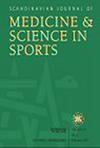Rethinking Acute Sports Injuries: Evidence for an Overuse Mechanism in Hamstring and ACL Injuries.
IF 3.8
2区 医学
Q1 SPORT SCIENCES
引用次数: 0
Abstract
Sports injuries have traditionally been classified as acute or overuse based on their onset and associated circumstances. Hamstring strain injuries and anterior cruciate ligament (ACL) injuries are two common sports injuries that are typically implicitly considered to represent acute injuries. This brief review, however, argues that hamstring and ACL injuries may at least partly present as overuse injuries resulting from a mechanical fatigue phenomenon, rather than acute injuries. Human, animal, and cadaveric studies are discussed to support this view. For example, human studies show no kinematic deviation in the stride during which the hamstring injury occurs as compared to the preceding strides. Further, the location of injury and ultrastructural damage of hamstring injuries is largely comparable to that seen in repetitive muscle-tendon unit lengthening experiments in animals. For the ACL, repetitive simulated jump landings have been shown to lead to ACL failure despite the ACL load being well below its ultimate strength. Furthermore, analyses of ACL explants obtained from noncontact ACL-injured patients during reconstruction surgery indicate similar damage to cadaveric studies that repetitively loaded the ACL. In summary, studies with diverse methodological approaches support the view that mechanical fatigue may predispose hamstring and ACL tissues to failure at submaximal loads during seemingly normal movements. Although further research is needed to substantiate these hypotheses, recognizing mechanical fatigue as a factor in these injuries can inform training and rehabilitation protocols and open opportunities to use modeling approaches and wearable sensors to monitor tissue load and damage, ultimately reducing injury rates.重新思考急性运动损伤:腘绳肌和前交叉韧带损伤过度使用机制的证据。
传统上,运动损伤根据其发病和相关情况分为急性或过度使用。腿筋拉伤和前交叉韧带(ACL)损伤是两种常见的运动损伤,通常被认为是急性损伤。然而,这篇简短的综述认为,腿筋和前交叉韧带损伤可能至少部分是由于机械疲劳现象引起的过度使用损伤,而不是急性损伤。本文讨论了人类、动物和尸体的研究来支持这一观点。例如,人体研究表明,与之前的步幅相比,在腿筋损伤发生的步幅中没有运动学偏差。此外,腘绳肌腱损伤的损伤位置和超微结构损伤在很大程度上与动物重复性肌肉肌腱单位延长实验相似。对于ACL,尽管ACL负荷远低于其极限强度,但重复的模拟跳跃着陆已被证明会导致ACL失败。此外,对重建手术中非接触性ACL损伤患者获得的ACL外植体的分析表明,重复加载ACL的尸体研究的损伤类似。总之,各种方法的研究都支持这样的观点,即机械疲劳可能使腘绳肌和前交叉韧带组织在看似正常的运动中承受次最大负荷时发生损伤。虽然需要进一步的研究来证实这些假设,但认识到机械疲劳是这些损伤的一个因素,可以为训练和康复方案提供信息,并为使用建模方法和可穿戴传感器来监测组织负荷和损伤提供机会,最终降低损伤率。
本文章由计算机程序翻译,如有差异,请以英文原文为准。
求助全文
约1分钟内获得全文
求助全文
来源期刊
CiteScore
7.90
自引率
4.90%
发文量
162
审稿时长
3 months
期刊介绍:
The Scandinavian Journal of Medicine & Science in Sports is a multidisciplinary journal published 12 times per year under the auspices of the Scandinavian Foundation of Medicine and Science in Sports.
It aims to publish high quality and impactful articles in the fields of orthopaedics, rehabilitation and sports medicine, exercise physiology and biochemistry, biomechanics and motor control, health and disease relating to sport, exercise and physical activity, as well as on the social and behavioural aspects of sport and exercise.

 求助内容:
求助内容: 应助结果提醒方式:
应助结果提醒方式:


